 Neuerscheinungen 2015Stand: 2020-02-01 |
Schnellsuche
ISBN/Stichwort/Autor
|
Herderstraße 10
10625 Berlin
Tel.: 030 315 714 16
Fax 030 315 714 14
info@buchspektrum.de |

Karel J. H. Vriezen, Ute Wagner-Lux
(Beteiligte)
Gadara - Umm Qes II
The Twin Churches on the Roman-Byzantine Terrace and Excavations in the Streets
Herausgegeben von Vriezen, Karel J. H.; Wagner-Lux, Ute
2015. XII, 387 S. 19 Diagr., 125 Abb. 29.7 cm
Verlag/Jahr: HARRASSOWITZ 2015
ISBN: 3-447-10452-X (344710452X)
Neue ISBN: 978-3-447-10452-4 (9783447104524)
Preis und Lieferzeit: Bitte klicken
The second volume in the series on the archaeological exploration of ancient Gadara (Umm Qays, Jordan) by the German Protestant Institute for the Archaeology of the Holy Land (Amman) concentrates on the three areas of the Decapolis city that have been excavated in cooperation with the Theological Faculty of Utrecht University.
The large terrace, down the slope of the upper city, was an urban focal area overlooking the lower city. Its western retaining wall was buttressed by a line of rooms, with a street or a piazza in front. The original remains on the terrace, constructed in the 2nd century C.E., may have been from a large Roman forum basilica. In the 6th century, the layout was completely remodeled into a Byzantine ecclesiastical compound, with a centralized church, a basilica, and courtyards, which - deducible from the tombs and reliquaries found - have perhaps served as a pilgrims´ center. After the collapse of the terrace´s buildings, the street or piazza to the west remained in use through the Early Islamic to Mamluk times, as the Roman water system continued to attract people. In the center of the lower city, part of the main street (decumanus maximus) was excavated, and in the course of this, earlier building remains were discovered underneath.
In addition to the presentation of the excavated areas and their stratigraphy, the finds are described and discussed in separate contributions by various specialists on architecture, ceramics (Iron Age, Hellenistic - Mamluk periods), oil lamps, glass, coins, etc.


